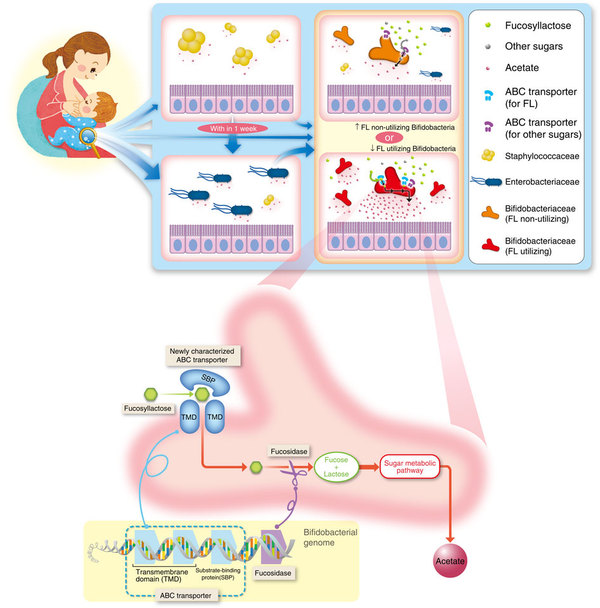Life Science and Technology News
Oligosaccharides in breast milk are key
Mechanism of how bifidobacteria become dominant in the gut in infants is unraveled
Tokyo Institute of Technology, Yakult Central Institute, and Teikyo University have jointly unraveled the mechanism which shapes intestinal flora1 (microbial communities in the intestines) of infants in its transition towards dominance of bifidobacteria. The gist is as listed below.
- It had been known that bifidobacteria become dominant in the intestinal flora in infants, but the mechanism was not known.
- This research made evident that the intestinal flora of infants change significantly in the month after its birth, their bacteria flora composition changing from one dominated by bacteria belonging to the family Enterobacteriaceae and the family Staphylococcaceae to one dominated by bifidobacteria.
- They unraveled, using genomic analysis, that "fucosyllactose" (FL)2, which is a major component of oligosaccharide contained in breast milk, plays a vital role in the dominance of bifidobacteria.
Overview
Assistant Professor Hiroshi Mori, Associate Professor Takuji Yamada, and Adjunct Professor Ken Kurokawa (also a Professor at the National Institute of Genetics), who teach Life Science and Technology, and Master's student Kazuya Yamamoto* (Department of Life Science and Technology), in collaboration with researchers of the Yakult Central Institute and the Teikyo University School of Medicine, et al., identified that "fucosyllactose" (FL), a component of breast milk oligosaccharide, is vital in the formation of infant intestinal flora dominated by bifidobacteria.
They found that the stool of infants with colonization of FL-utilizing bifidobacteria had a greater proportion of bifidobacteria, higher acetate concentrations, a lower proportion of Enterobacteriaceae, and lower pH values compared to those of infants without. They discovered the fact that a type of ABC transporter3 existing in specific bifidobacteria, which transports FL to bacterial cells, plays a central role in the formation of bifidobacteria-dominated intestinal flora. This shows that the utilization of oligosaccharides by bifidobacteria is vital in forming the symbiotic relationship between an infant and bifidobacteria, and is expected to lead to the unraveling of the significance of the bifidobacteria-dominant intestinal flora in infants.
*Position at time of research

Figure. Infant microbiota development and molecular mechanisms of FL utilization by bifidobacteria.
Infant gut microbiota showed 3 distinct clusters, which underwent directional transition to Bifidobacteriaceae-dominant microbiota, and displayed individual variations in the pace of progression. Isolated bifidobacterial strain showed differences in FL utilization. Colonization of FL-utilizing bifidobacteria are associated with altered gut acetate concentrations, pH, and Enterobacteriaceae and Bifidobacteriaceae abundances in the cohort, which have been previously shown to affect infant health. We subsequently identified a substrate binding protein of the multiple-sugar ABC transporter system is a key genetic factor of FL utilization.
a wide variety of microorganisms forms a community and inhabits the intestines of various organisms. This intestinal community of microorganisms can be called intestinal flora. In the case of adult human intestines, the community is estimated to be made up of over tens of trillions of cells, of over hundreds of species.
a type of oligosaccharide most present in human breast milk, with the molecular formula C18H32O15.
a structure composed of multiple proteins grouped together and existing on biological membranes such as cell membranes. Transports specific substrates through the membrane by utilizing ATP.
Reference
| Authors: | Takahiro Matsuki1, Kana Yahagi1, Hiroshi Mori2, Hoshitaka Matsumoto1, Taeko Hara1, Saya Tajima1, Eishin Ogawa3, Hiroko Kodama3, Kazuya Yamamoto2, Takuji Yamada2, Satoshi Matsumoto1, & Ken Kurokawa2, 4 |
|---|---|
| Title of original paper: | A key genetic factor for fucosyllactose utilization affects infant gut microbiota development |
| Journal: | Nature Communications |
| DOI : | 10.1038/ncomms11939 |
- Kurokawa, Nakashima, & Yamada Lab
- Researcher Profile | Tokyo Tech STAR Search - Hiroshi Mori
- Researcher Profile | Tokyo Tech STAR Search - Takuji Yamada
- Researcher Profile | Tokyo Tech STAR Search - Ken Kurokawa
- National Institute of Genetics
- Life Science and Technology Graduate Major
- Latest Research News
Further information
Assistant Professor Hiroshi Mori
Adjunct Professor Ken Kurokawa
School of Life Science and Technology
Email hmori@bio.titech.ac.jp
Tel +81-3-5734-3591
Contact
Center for Public Affairs and Communications
Email media@jim.titech.ac.jp
Tel +81-3-5734-2975





